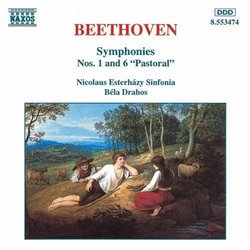Beethoven's First and Sixth Symphonies
Robin Friedman | Washington, D.C. United States | 10/22/2003
(4 out of 5 stars)
"This recording is part of a complete performance of the nine Beethoven symphonies on Naxos, a budget-priced label. The symphonies are performed by the Nicolaus Esterhazy Sinfonia, a Hungarian chamber orchestra conducted by Bela Drahos.Beethoven's symphony no. 1 in C major, op. 21 received its first performance in 1800 with the 29-year old composer conducting. This is a symphony that shows the influence of Mozart and, more so, of Haydn on the young Beethoven. (Haydn was Beethoven's teacher and Beethoven's music displays a brusqueness and earthiness that is more typical of this master than of Mozart.) The early classical influence is most apparent in the second and fourth movements of this symphony.Even in this first symphony Beethoven displays his own creative independence. The symphony has a propulsive forward-moving character that Beethoven would continue to develop. For me the music seems at several points almost ready to burst through the bounds of the earlier forms. The third movement, although marked "Minuetto" is in fact a lively scherzo that the interested listener might enjoy comparing with a Haydn or Mozart symphonic minuet. Altogether this is an energetic,and brash symphony that Beethoven scholar Donald Francis Tovey aptly described as bringing a fitting conclusion to the Eighteenth Century.Beethoven's sixth symphony in F major, the "Pastoral" symphony, op. 68 received its first performance in 1808 at the same concert in which the fifth symphony received its premiere. This is the only Beethoven symphony that is programmatic in character and the only one of his symphonies that consists of five rather than four movements. This symphony is highly accessible to those coming to Beethoven for the first time. It is lyrical,highly elevated in tone and tranquil with lovely interplay among the strings, the winds, and the tympani. The symphony has had its detractors over the years resulting from some of the efforts Beethoven made in the inner movements to emphasize the "bucolic" character of the work. But this remains in its song-like, serene character, transcendent beautiful music.The performance on this recording is by a small orchestra. Some people may not be used to such performances of the Beethoven symphonies, but it is idiomatic to the music. Several modern recordings of the symphonies feature smaller orchestras than had been the case, say, from the mid-19th to the mid-20th century. There is much to be derived from performing the music in this way, but it is not the only way to hear Beethoven.The recordings here on the whole work well. They feature slighly quick tempos and clear lucid sound. The listener can hear all the instruments and parts, including the winds which sometimes do not come through fully on recordings. There is a easy-going flow to the performance which avoids sentimentality or over-dramatization. There are moments when the performance stays too much on a single level and loses some of the power that would be conveyed by a larger orchestra. Also, I found that the performance here of the lovely second movement of the "Pastoral" broke down at points.I think this CD is valuable primarily for listeners new to classical music who are seeking an opportunity to hear Beethoven. Such listeners always ought to be encouraged. This disc might be an appropriate gift to young people or to others to introduce them to the "Pastoral" with little cost or risk. Those familiar with Beethoven's symphonies will enjoy comparing these performances with their favorite interpretations or memories of this music."
A serviceable recording of two Beethoven staples
David A. Baer | Indianapolis, IN USA | 02/14/2007
(4 out of 5 stars)
"
Naxos cut its teeth on this kind of recording. Two sturdy Beethoven symphonies are played by a Central European (in this case Hungarian) orchestra with good, serviceable effect.
This CD will not knock your socks off. It *will* get you into Beethoven in a way that honors the composer and costs you but a song.
This is the kind of CD that broke classical recordings out of the elitist box and into the arena where just about anyone with a will and a small number of dollars can own quality music.
I say 'Bravo!' to Naxos and 'well done!' to Béla Drahos and his compatriots."


 Track Listings (9) - Disc #1
Track Listings (9) - Disc #1

